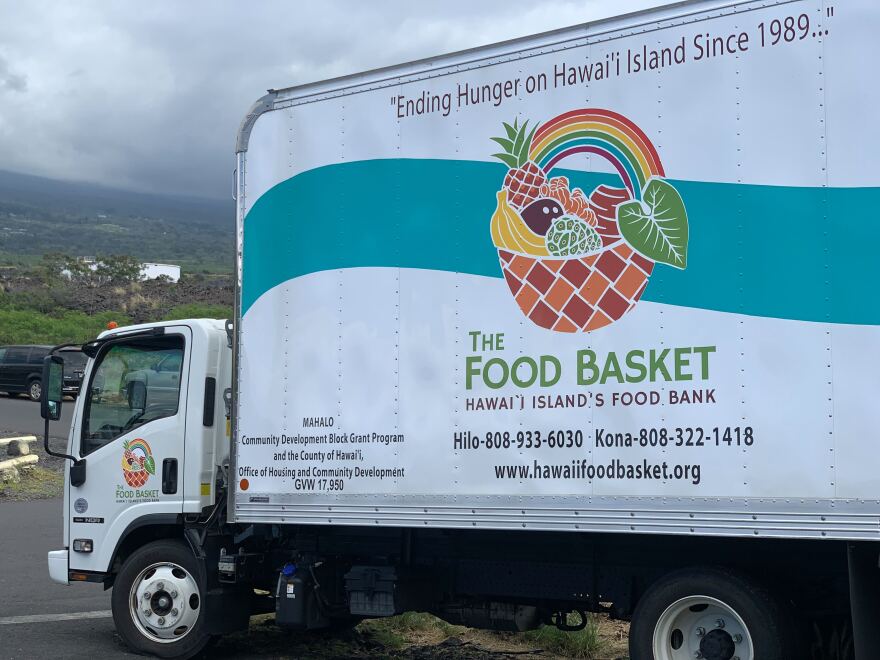A new study highlights Hawaiʻi’s growing food insecurity and ongoing systemic issues surrounding access.
The second food insecurity study by the Hawaiʻi Foodbank indicates that 32% of local households didn’t have enough food between mid-2024 and mid-2025 — up 3 percentage points from the organization’s first report covering 2023.
Food bank officials said, anecdotally, demand for assistance has been growing over the last few years, and is reaching peaks not seen since the height of the pandemic.
Leaders from all the counties' major food banks, part of Hawaiʻi’s Food Bank Hui, presented the findings Monday.
“These challenges don't arise overnight. They stem from longstanding structural barriers, our geographic isolation, limited transportation options, and the high cost of imported goods — most of those coming from over 2,500 miles away," said Kristin Frost Albrecht, the executive director of the Hawaiʻi Food Basket on the Big Island.
"All of this makes nutritious food both expensive and harder to access, particularly in our rural communities."
The report, which analyzed surveys from more than 1,000 households, found that food insecurity rates have grown in every county except for Honolulu, with Maui County seeing the biggest jump — from 31% to 41%, in part due to the 2023 fires.
“ The lasting effects of the fires, we're still seeing them and feeling them. Families are still displaced or rebuilding," said Lisa Paulson, CEO of the Maui Food Bank. "We're also seeing, with the recent shutdown and tourism decline, we're seeing a lot of new faces in our lines, and our phones are ringing off the hook.”
The respective rates on Oʻahu, Hawaiʻi Island and Kauaʻi were 28%, 40% and 23%, respectively.
Though Oʻahu's rate only dropped slightly, the 247,000 food-insecure individuals on the island are more than the rest of the state combined.

Asian Americans, Native Hawaiians and Pacific Islanders again experienced higher rates of food insecurity compared to other racial and ethnic groups, the report found.
The food bank hui highlighted that 47% of surveyed Filipinos experience food insecurity — a rate unchanged from the 2023 report.
Native Hawaiians and Pacific Islanders were grouped in this year’s report, and 36% of surveyed households experienced food insecurity — a drop from the respective 43% and 45% rates in 2023.
Adults between 18 and 29 years old were the most impacted by hunger. The study found that 53% have been impacted by food insecurity over the last year or so, up from 49%.
“This does match with some other things that we know about this age cohort. Kids are having a harder time getting jobs, and a harder time with housing and rent,” said Amy Miller, president and CEO of the Hawaiʻi Foodbank.
Food insecurity among local students in higher education also jumped from 44% to 58%. Additionally, 41% of those who identified as being part of Hawaiʻi’s LGBTQ community reported experiencing food insecurity.
More than one-third of households with children reported experiencing food insecurity — a 5 percentage point increase over 2023. Adults in these households experience a particularly high rate of food insecurity, which the report said is “indicative that parents and caregivers will sacrifice their own food security before letting their children go without food.”
Recent federal funding impacts
While the updated study highlights the increased systemic issues over the last few years, it doesn't encompass the most recent federal funding impacts, which could worsen food insecurity.
Earlier this year, local food banks lost $4 million as part of the Trump administration’s slashes to federal spending.

The federal shutdown, coupled with uncertainty over the $60 million in Supplemental Nutrition Assistance Program funding meant for Hawaiʻi, at least temporarily pushed families further toward food insecurity.
But the federal government’s cuts and changes to SNAP and Medicaid are likely to lead to worsening hunger.
The state has assisted over the last few weeks to fill the funding gaps left by the federal government, and food banks have received food, money, and volunteer hours.
“For every phone call we got for someone seeking food assistance, we got a phone call from somebody saying, ‘How can I help?’ Our volunteer shifts filled up almost as fast as our registration for our distributions,” Miller said. “We're here because this is an issue that we really need to address together.”
Hawaiʻi Public Radio exists to serve all of Hawai’i, and it’s the people of Hawai’i who keep us independent and strong. Help keep us strong to serve you in the future. Donate today.






